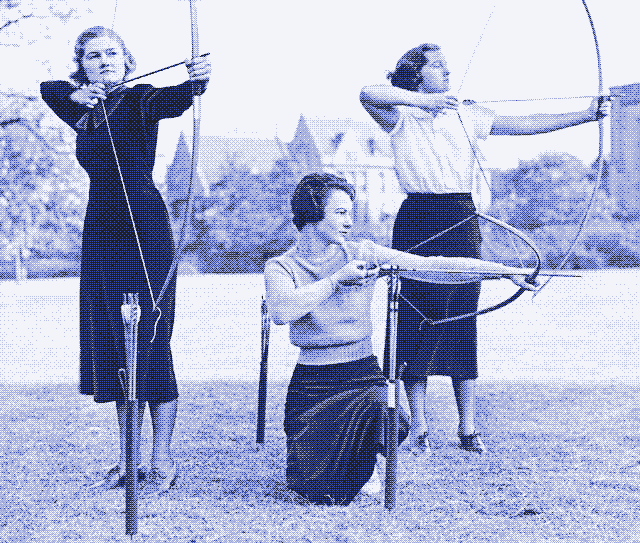
Why did firearms and bullets replace bows and arrows? To many, this sounds like a stupid question with an obvious answer: the firearm succeeded the bow because it’s a superior weapon. Let’s investigate.
Strength and skills
Hand-held firearms are usually assessed or compared in terms of performance characteristics such as lethality, range, and rate of fire. However, if we apply the same criteria to bows, two difficulties quickly present themselves. First, the performance of the bow depends on the archer’s strength. The bow is a human-powered weapon and thus only as powerful as the archer who draws it. That is not the case with the firearm, where the energy comes from explosives, and the shooter’s strength is of little importance.
The force required to pull a specific bow is typically measured in pounds (lbs) and expressed as the bow’s “draw weight.” Nowadays, most recreational archers and bow hunters shoot bows with a draw weight of 30 to 70 lbs. The effort to draw such a bow corresponds to lifting a weight of 15 to 35 kg. 1 Similar draw weights seem to have been quite common throughout (pre)history, both for hunting and warfare. However, some archers used bows with higher draw weights. For example, during the heydays of the longbow in medieval England, the draw weight for war bows peaked between 100 and 140 pounds, with some archers shooting 200 pounds weapons. Composite bows had higher draw weights, too. 23456
The bow is a human-powered weapon and thus only as powerful as the archer who draws it
Second, how the bow performs depends to a large extent on the skills of the archer. 467 Both the bow and the firearm require the shooter to develop aiming skills. However, the archer first has to master “pulling the trigger.” He or she needs to perform a sequence of actions flawlessly to make an accurate shot even possible. A slight variation in body posture or a jerky string release is enough to make the arrow go off the mark. In comparison, pulling the trigger of a firearm requires less practice. Aiming is more difficult with a bow than with a firearm as well. Unless the target is very close, the archer needs to compensate for gravity and shoot the arrow in an arc – hence the word archery. 8 Because bullets travel much faster than arrows, a gunner can aim in a straight line, which is easier.
Preindustrial bow vs. modern firearm
For reasons that will become clear, I compare the modern firearm to the preindustrial bow, not the modern bow. I include self-bows (made from a single stave of wood) and composite bows (which consist of layers of different materials, usually wood, horn, and sinew). Furthermore, I assume that a relatively strong and skillful archer draws the bow. We have a pretty accurate picture of what premodern archers and their weapons could accomplish, thanks to written resources, archeological evidence, and scientific experiments with replicas of preindustrial weapons.
1. Lethality
The lethality of a weapon is the capacity to cause death or harm. Every weapon can kill, but some are more likely to do so than others. The lethality of firearms is often defined by calculating momentum and kinetic energy of bullets. These concepts from physics indicate the ability of bullets to penetrate a target. Penetration increases with the projectile’s speed and weight. Bullets travel faster than arrows, but arrows are heavier than bullets. 9
Nevertheless, if you calculate the momentum and kinetic energy of arrows, even the most potent bow seems much less lethal than a firearm. When shot from a 170 lbs war bow, an arrow’s kinetic energy is only 96 foot-pounds, compared to 117 foot-pounds for a bullet fired from a small 0.22LR caliber pistol, 383 foot-pounds for a round fired from a 9 mm caliber pistol, and 1,300 to 2,800 foot-pounds for a projectile fired from a rifle. 10 The difference for momentum is smaller, but bullets clearly win in both cases.
Arrows are much more energy efficient than bullets. The shape of an arrow – unlike that of a bullet – favors penetration.
However, arrows are much more energy efficient than bullets. The shape of an arrow – unlike that of a bullet – favors penetration. Because of its elongated shape, an arrow’s mass per cross-sectional area (the sectional density) is much higher than in the case of a bullet. 111213 Consequently, an arrow requires much less momentum and kinetic energy to penetrate tissue to the same depth as a bullet. There is no need for a 170 pounds war bow – a bow with a draw weight of 45 lbs can kill almost any creature on this planet. Medieval English longbow archers only used such high draw weights because their arrows had to penetrate thick steel plate armor, which became common in the 1400s. 64
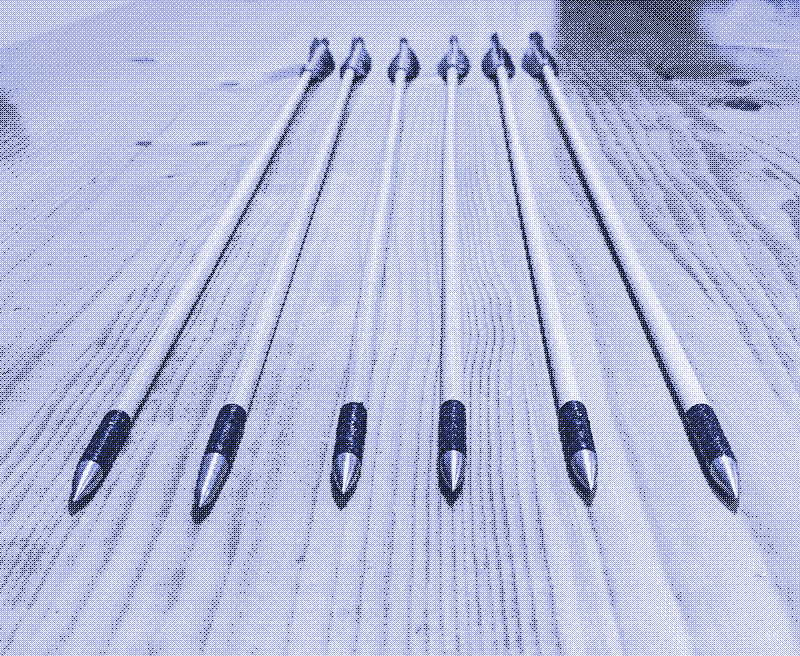
However, bullets do more damage when they hit the target. Arrows penetrate tissue by slicing and cutting, similar to the damage done by a dagger or a knife. Consequently, injury is limited to the tissue incised by direct contact with the arrowhead. In contrast, bullets penetrate tissue by brute force, which can cause significant damage to tissue and organs not directly touched by the projectile. This effect becomes more pronounced as bullet caliber and speed increase and is most noticeable with rifles. 911121415
Based on wound damage alone, one could thus argue that bullets are more lethal than arrows. Small caveat, though: if the archer is skillful enough to hit vital body parts, an arrow can be just as lethal. The gunner, on the other hand, doesn’t need to aim so precisely to make a kill. Furthermore, it can be difficult – and sometimes impossible – to remove arrowheads from a victim’s body, even in a modern healthcare context. 11 Arrowheads tend to get stuck into bones, and war arrowheads often had barbs that complicated removal. 16
2. Range
Range distinguishes a missile weapon from a melee weapon (used in close combat). The person holding the weapon with the most range can hit the other while the other cannot hit back. In hunting, range makes it less likely that the hunter gets killed. The maximum range of a weapon defines how far you can shoot a missile, and the effective range marks how far you can cast it with sufficient accuracy and hitting power.
Conveniently, a bowshot was a common measure of distance. In England, it was eventually standardized at 204 yards (187 meters). 6 Being a standard, this was not the range obtained by stronger archers, who used bows with higher draw weights. 2 Historical sources from the middle ages put the maximum range of a war longbow between 200 and 400 yards (183-366 meters). 46 The current record with an English longbow, established in 2017, is 412.82 m. 17 Composite horse bows obtained longer ranges, between 300 and 530 meters. 18 The current record, established in 2019, stands at 566.83 meters. 1920
Unlike a bullet, an arrow remains lethal during its entire flight
Modern firearms have a much greater maximum range than preindustrial bows. However, their effective range is similar, at least for pistols and guns (not so for rifles). For example, the maximum range of a Beretta M9 handgun – a US military weapon – is 1,800 meters, but its effective range is only 50 meters. The US Army defines the effective range of a firearm as the maximum range at which an average soldier can hit a stationary, torso-sized target with an accuracy of 51%. I could not find similar data for archers, but the available information suggests that the bow can obtain a similar accurate range.
For example, a study of a 1916 archery competition in New Jersey – when archers still shot wooden self-bows – revealed the accuracy of the five best archers, each shooting a total of 90 arrows from three different distances: 40, 50, and 60 yards (37, 46 and 55 meters). The target measured 121 cm in diameter (the typical practice target), not a human torso but a comparable size. The percentage of arrows that hit the target was 98% at 37m, 96% at 46m, and 88% at 55m. 2122
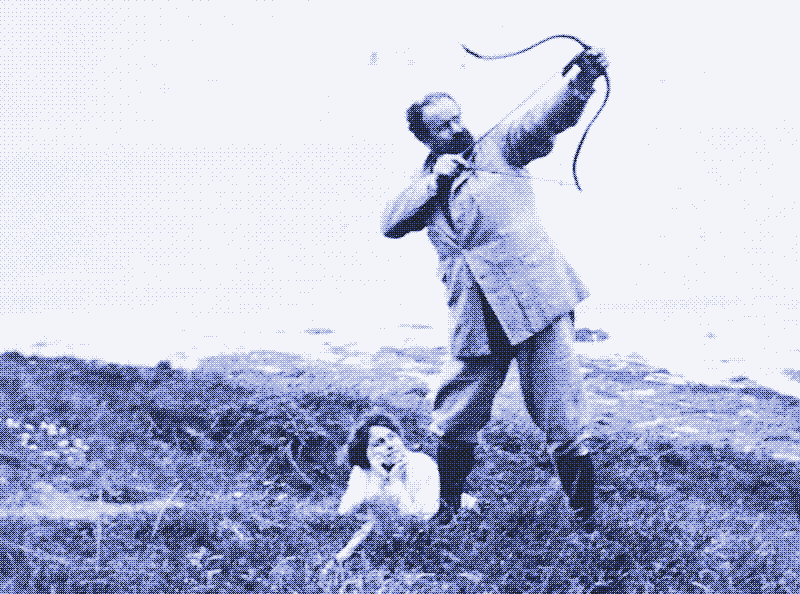
Comparing the range of bows and firearms is far from straightforward. Bullets travel very fast initially (almost 3,000 km/h) but quickly lose speed along their trajectory. In contrast, an arrow travels relatively slowly (150-250 km/h) but loses very little speed. 23 The same characteristics that make it easily penetrate a target also help to penetrate the air. Furthermore, unlike bullets, arrows fly – they are among the first applications of aeronautics, thousands of years before the invention of the airplane. 924
As a consequence, an arrow remains lethal during its entire flight, even at maximum range. Stronger still, its lethality increases if shot at an angle of 45 degrees, compared to shooting at medium range. 46925 The arrow will gain speed – and thus momentum and kinetic energy – on its way down. In contrast, when you shoot a bullet in an arc for maximum range, it will have lost so much speed that it’s unlikely to be lethal when it hits the ground. 26 A bullet not only needs more momentum and kinetic energy to penetrate a target. It also requires more speed to compensate for its inferior aerodynamics.
Although the accurate range of bows is smaller than that of rifles (which can be effective up to a distance of several hundreds of meters or more), the maximal cast of powerful bows equals the effective range of some rifles. As we shall see later, unlike recreational archers in the West today, preindustrial archers routinely practiced their skills at the ultimate range of their weapons. 27
3. Rate of fire
The rate of fire determines how many projectiles a weapon can launch in a given time frame. The higher the rate of fire, the higher the chance that one of the projectiles will hit the target.
When visiting a modern archery shooting range, one gets the impression that bows have a much lower rate of fire than firearms. However, modern archery is 100% focused on millimeter accuracy. Aiming is a slow process that often involves fiddling with instruments and looking through sights – many modern bows are essentially sniper weapons. Previously, archers aimed intuitively, with both eyes open and fixed on the target. Intuitive aiming requires more skill – it depends on eye-body coordination, like throwing a stone – but it can be just as accurate and has the obvious advantage of speed.
Medieval English archers had to be able to shoot 10 to 12 well-aimed arrows per minute – one shot every 5 to 6 seconds. 6928 The best longbow archers could launch up to 30 missiles per minute – one every two seconds. 29 This is comparable to the sustained rate of fire for semi-automatic firearms – between 12 and 15 rounds per minute. 30 The sustained rate of fire includes the time it takes to aim, reload, and prevent overheating and malfunctioning of the firearm. For the bow, it depends on the dexterity, strength and endurance of the archer.
In the hands of skillful and strong archers, bows can produce a similar rate of fire as semi-automatic weapons, and they can outperform guns and pistols
Firearms can surpass their sustained rate of fire for a short time, ignoring the time for cooling down the weapon. Most semi-automatic weapons (which fire one bullet for each pull of the trigger) obtain a rapid rate of fire of about 45 rounds per minute. If there is no need to reload ammunition, the rate of fire can increase even further. The average shooter can fire a semi-automatic handgun at a rate of about 2 to 3 bullets per second while pointing at a single stationary target. However, military training aims to produce a well-aimed shot every one to two seconds. 30
Composite bow archers, in particular, developed ways of shooting that could compete with the rapid rate of fire for semi-automatic weapons. Horse archers launched arrows with a thumb draw, which differs from the Mediterranean draw used by self-bow (and modern) archers. The horse archer put the projectile on the other side of the bow (right side if right-handed) and pressed it against the string with a thumb ring. The thumb draw allows you to nock and launch with one continuous movement. Some Native Americans used the pinch draw – which had similar advantages. 31
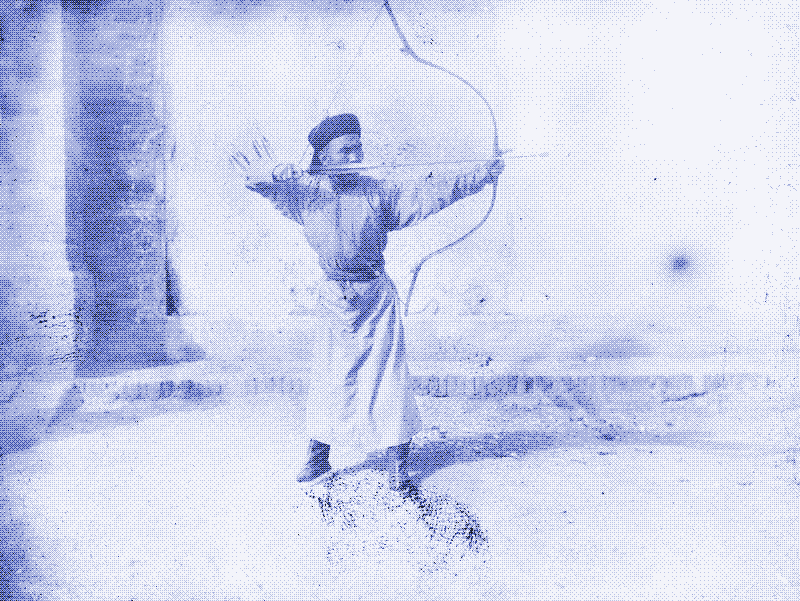
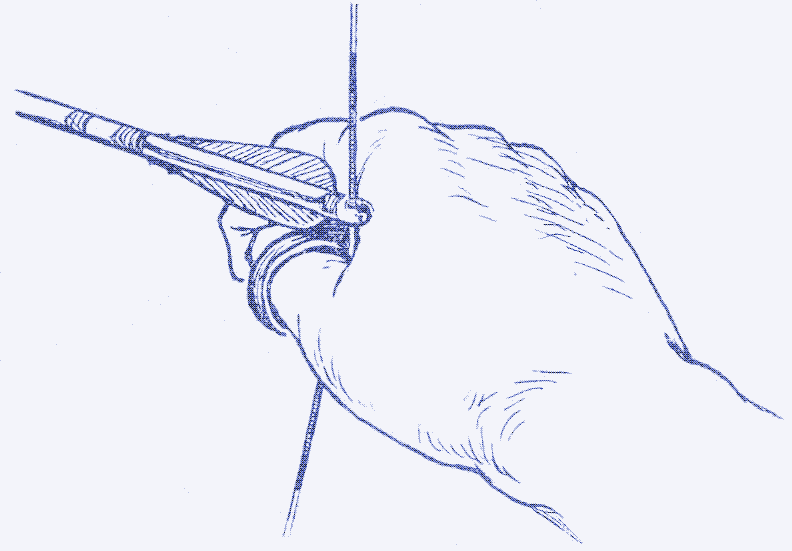
For short bursts of fire, composite bow archers kept extra arrows in their bow or string hand, allowing a higher rate of fire than when pulling arrows from a quiver. The fastest way of shooting involved laying up to five arrows on the bow parallel to each other, nocking each one consecutively. Lars Anderson, a Danish archer who revived the interest in Asian archery in the West in recent years, shoots up to ten aimed arrows in just 5 seconds – two per second. Anderson also manages to shoot three arrows in just 0.6 seconds after putting them ready on the bow. 32
4. Ammunition supply
In the hands of skillful and strong archers, bows can thus produce a similar rate of fire as semi-automatic weapons, and they can outperform guns and pistols. However, they cannot compete with automatic firearms (machine guns), which fire bullets as long as the shooter presses and holds the trigger. The machine gun appeared in the 1860s and can fire 30 rounds in just two seconds. 30
Furthermore, most archers will run out of ammunition faster than gunners. English longbow archers carried a maximum of about 25-50 arrows with them, which would all be gone after shooting a few minutes at maximal rate of fire. In contrast, US soldiers take seven magazines with a total supply of 200 bullets. 30 On their campaign in France, English archers were followed by dozens of supply wagons with spare arrows. 6
Parthian horse archers operated with a camel supply of more than 1,000 animals loaded with spare arrows
Horse archers carried more ammunition, from 60 to 80 arrows and up to 400 arrows in saddleside quivers. Their tactics were also aimed at keeping the enemy on the move, which facilitated the collection and reuse of their arrows. Horse archers could quickly ride to the supply train and back. Parthian horse archers, who defeated the Roman army several times, operated with a camel supply of more than 1,000 animals loaded with spare arrows. 25
5. Stealth & handling
A weapon’s size and the space required to use it also determine its performance. Preindustrial bows were featherlight (around 500 g) but larger than modern firearms, and the archer needed more elbow room to launch a projectile. A gun or rifle can be shot from almost any position, while a self-bow is most effective when the archer is standing. That makes it harder for the archer to conceal himself and makes the weapon unpractical in some environments. Its size and light weight also makes the bow an inferior melee weapon. Archers usually carried a sword for hand-to-hand combat. 8 In contrast, the modern firearm works as a ranged and melee weapon.
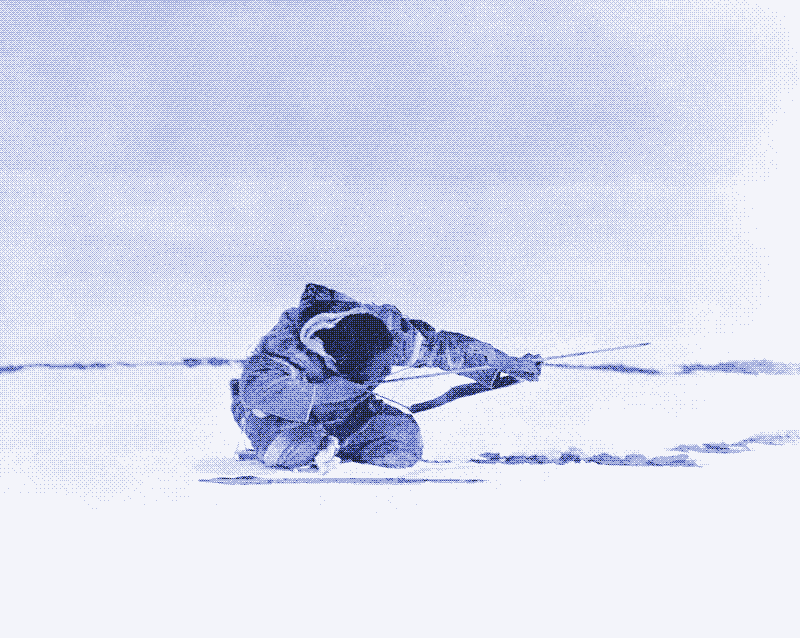
On the other hand, the composite bow is much shorter than the self-bow. The thumb release gives the archer flexibility to be able to shoot to any direction and nearly in any position. There are also historical examples of small “pocket bows” with short draw lengths, lethal only at short range. 33 Furthermore, although the size of some bows makes it harder for the archer to conceal himself, bows partly compensate for this by being silent. The sound of a gunshot immediately gives away the position of the shooter.
When inferiority ruled: early firearms
When comparing the performance characteristics of preindustrial bows and modern firearms, it’s tempting to conclude that firearms replaced bows because they are indeed technologically superior. The difference in performance may not be as big as many people would have suspected. But even the most skillful archers from the middle ages could not compete with all types of modern firearms, especially not with rifles and machine guns.
However, bows became obsolete centuries before the advance of modern firearms. On the Europen continent, firearms – first the arquebus, then the musket – became the dominant hand-held missile weapons from the 1500s onwards. 934 The reason could not have been a better technical performance, because preindustrial firearms were in almost every respect inferior to bows. Firearms only matched bows in technical performance between the 1850s and the 1900s, thanks to industrial manufacturing methods. 925
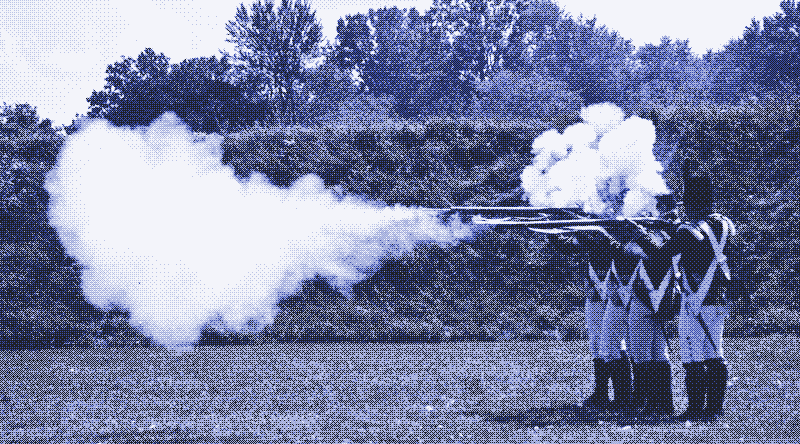
The only technical advantage of early firearms was their lethality. Just like today, a bullet did more damage than an arrow. 3536 However, unlike today, actually hitting the target was quite a challenge. Compared to bows, early firearms were inaccurate, had a short range, and a low rate of fire. Before the twentieth century, gunners received no training at all because firearms were inaccurate, even in the hands of experienced shooters. 28 As late as 1793 – after roughly 300 years of use on the battlefield – a series of trials in England showed that the musket was less accurate than the longbow. 35 Around the same period, Benjamin Franklin considered arming American Revolutionary soldiers with longbows because they were more efficient than muskets. 4252837
As late as 1793 – after roughly 300 years of use on the battlefield – a series of trials in England showed that the musket was less accurate than the longbow
The main weakness of early firearms – and the last one to be solved – was their low rate of fire. The musketeer had to follow a series of manual steps for every shot. 35 In the time a man needed to load his musket and fire one round, a skillful archer could launch up to a dozen arrows towards him. During the US Civil War (1861-1865), the range of rifles had become similar to the range of war bows (200-300 yards), but the rate of fire was still as low as three bullets per minute. 9 Preindustrial firearms were also unreliable, while bows seldom failed. Even in the late 1700s, roughly 15% of musket shots misfired, increasing to 90% in wind and rain. Finally, a musket was as long as a bow and much heavier (7-9kg). 37

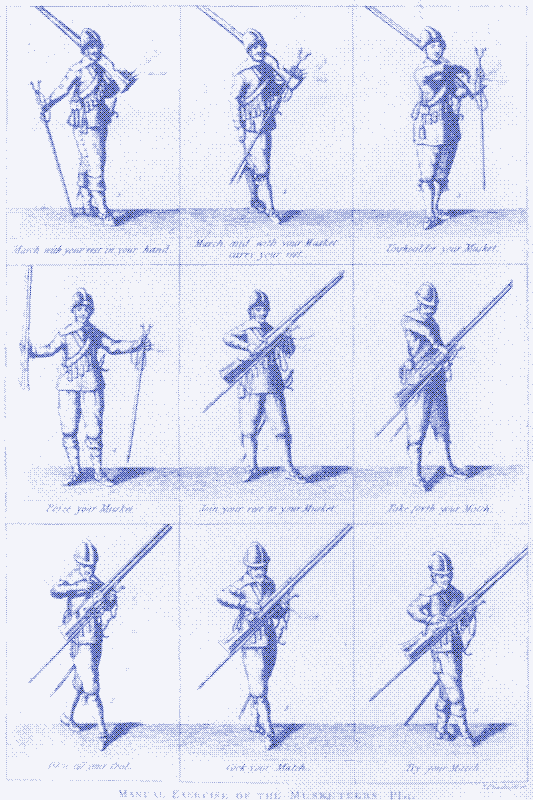
The firearm also had tactical disadvantages. First, while the flat trajectory of bullets made aiming easier, it also meant that the volume of fire was limited further. 46 Archers could stand in deep formations and shoot simultaneously with several ranks at once – the archers in the back shooting over the heads of those in front. This technique, called “volley shooting”, had been in use since Antiquity. 25 In contrast, only two ranks of musketeers could shoot simultaneously (one rank kneeling, the other standing). Likewise, musketeers could only target the front ranks of an enemy force, and they could not lob their projectiles over a castle wall.
Second, archers could kill indirectly (and cause a lot of destruction) with fire arrows. These were slightly longer projectiles that carried combustible materials. Some types were for immediate use, while others required preparation in the field. 438 Their effect could be devastating in a time when people made buildings and ships from flammable materials. Defensive forces could set fire to supply wagons or siege engines of attacking armies. 6 Horse archers ignited the high grasses of the steppes to stop opposing troops. 34 Using fire arrows, bows were “firearms”, too.
The crossbow
The firearm was not the first weapon to replace the bow. On the European continent, the crossbow became the dominant missile weapon in warfare by the 1200s. Early firearms then largely superseded crossbows in the 1500s. 46 The crossbow, around since Ancient times, is a human-powered spring just like the bow. However, its operation is very much like that of a firearm. The projectile is locked in place, and the shooter only needs to aim to make an accurate shot. The crossbowman tensions the weapon through different mechanisms, like a stirrup, a double crank windlass, or a pulley system.
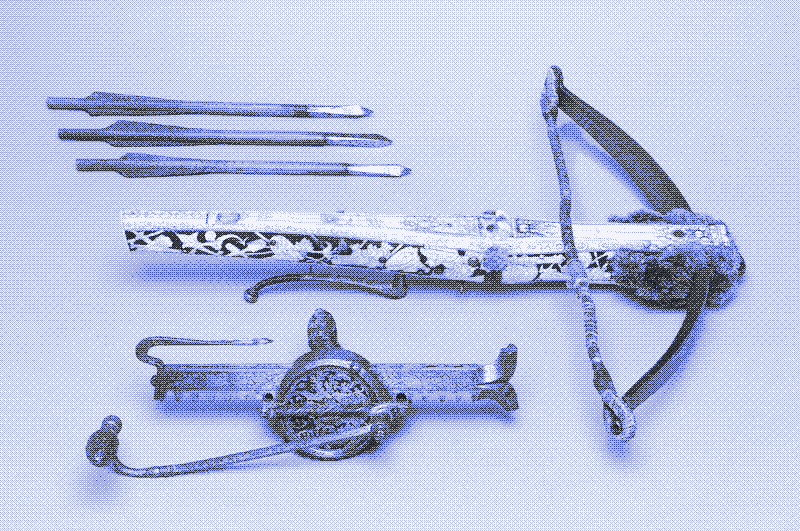
People often consider the crossbow technically superior to the bow, and that it largely replaced the bow in Europe only seems to confirm this. However, a comparison of the performance characteristics shows two equally valid weapons, each with its own advantages and disadvantages. A crossbow bolt was more powerful than an arrow, making it better suited for piercing armor. 39 Furthermore, a crossbowman needed less elbow room and could wear heavier body armor that would have interfered with the operation of a bow. 8 However, the crossbow was very heavy and its rate of fire was just as low as that of a firearm. Neither were crossbows suited for launching missiles in an arc.
When we compare the performance of the crossbow to that of the early firearm, a curious observation follows: the crossbow is clearly the superior weapon. It shared the low rate of fire with the early firearm, but at least the crossbow had an accuracy, range, and reliability that could match the bow. The crossbow was also relatively silent in operation and did not produce smoke (as all early firearms did). And yet, the firearm replaced the crossbow, not the other way around. Consequently, contrary to what most people assume, the bow and the crossbow were not succeeded by weapons that were superior in their technical performance. The opposite happened. Between 1400 and 1900, European armies replaced first-rate weapons by inferior weapons.
Taking the skill and effort out of killing someone
Looking at performance characteristics alone, the evolution of hand-held missile weapons in Europe seems to make little sense. Differences in manufacturing techniques don’t seem to explain it either. Bullets were cheaper to produce than arrows, but self-bows were more economical to make than firearms. The sequence from bow to crossbow and firearm makes more sense when we compare these weapons in terms of their learnability. The crossbowman only needed to aim well and could shoot in a straight line instead of an arc, which made the crossbow simpler to use than the bow. It also required less muscular strength than the bow, but the crossbow was still a human-powered weapon. The firearm did away with that.
Rather than being technically superior weapons, firearms took the skills and muscular effort out of killing someone from a distance
Rather than being technically superior weapons, firearms took the skills and muscular effort out of killing someone from a distance. The main reason most European armies switched from bows to crossbows and then firearms was the short learning curves of these weapons. Crossbowmen and musketeers required little or no training, while it took many years of practice to build an archer skillful and strong enough to be of use in warfare. 46784041 The crossbow and the firearm thus expanded the number of people in a given population that could become soldiers. That was great news for those in power because they could now build large armies quickly.
Archery practice
The importance of learnability is easy to forget nowadays because firearms are extremely easy to operate. With a machine gun, it’s not even necessary to aim well. In contrast, putting together and maintaining an army of archers required a lot of effort. Wherever the bow was an important weapon on the battlefield, archery practice was part of daily life. A well-documented example is England, where the longbow was retired from military service only in 1595 – roughly 400 years after most European armies had switched to crossbows and a century after the advance of early firearms.
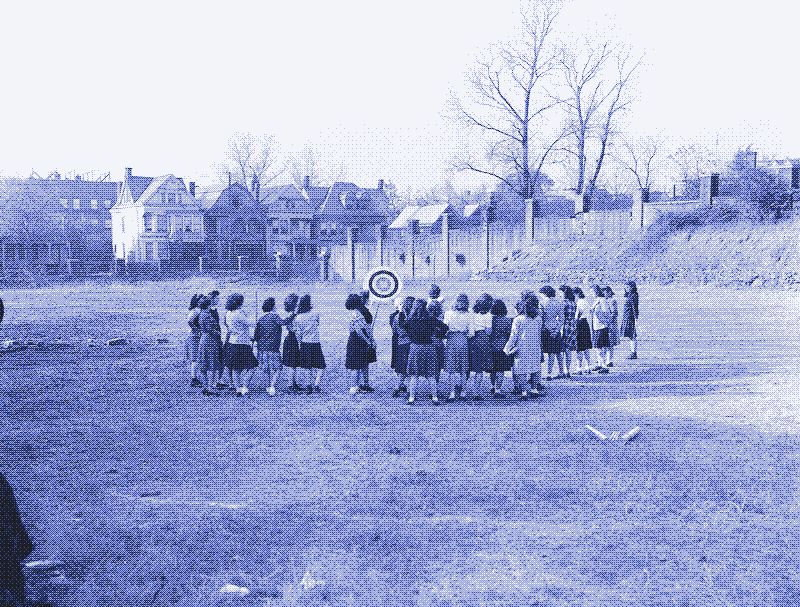
The English crown forced its entire male population to practice archery. Legislation started in the 1250s and became increasingly strict in the centuries that followed. 4642438 All men between the ages of 17 and 60 had to own a longbow and were obliged to practice on Sundays and festive days. Parents had to provide boys with a bow and arrows by age seven. Other sports as football, tennis, and handball, were outlawed to eliminate distractions from archery practice.
Wherever the bow was an important weapon on the battlefield, archery practice was part of daily life
The principal mode of archery practice was shooting at the butts. These were mounds of earth, stone, and peat situated on common land that measured up to 200 meters long. These shooting grounds (known as butts, too) could be in the open countryside, within towns and villages, or on land adjoining castles or forts. 4644 Archery practice also involved prick or clout shooting, which is the art of shooting an arrow in a large arc and dropping it into a target from above at maximum range. This trained archers in volley shooting. Another form of practice was shooting at the popinjay, almost straight up into the sky. This trained archers for sieges and naval battles, where they had to hit targets high in the rigging of enemy ships.
In horse archer cultures, the type of practice was different, reflecting more mobile tactics on the battlefield. 25 The most typical military training in composite bow cultures were games where archers ran their horses over specially designed tracks, shooting sideways, backward, and up in the air at consecutive targets along both sides of the route. A 17th-century Ottoman archery manual of military horsemanship described nearly 20 different drills, sometimes combining the bow and the sword. 4 Many nomadic people taught their children to ride animals and shoot bows from a very young age. 37
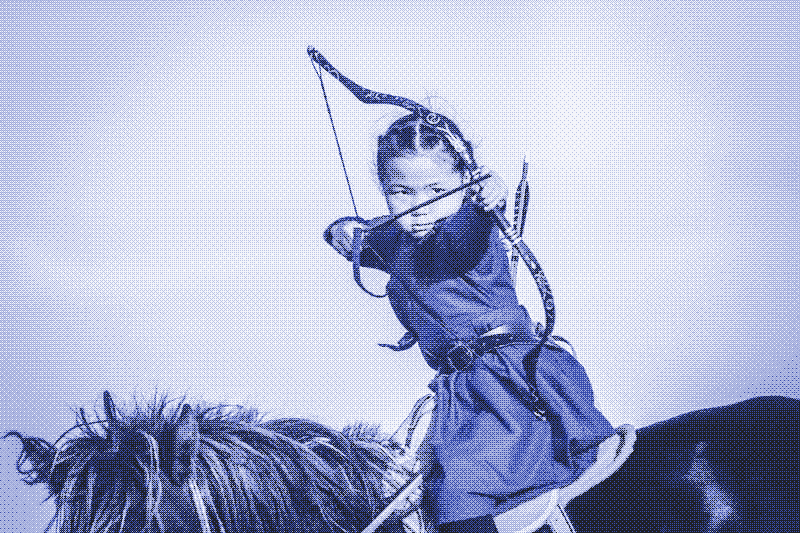
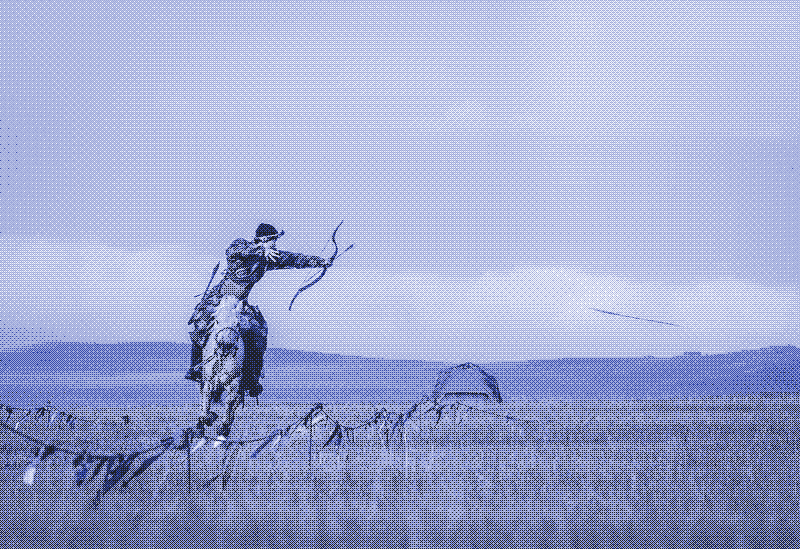
For many centuries, archery was a religious duty and a sign of status in the Islamic Crescent, from Turkey to India. It developed as a martial art and a ritual practice that supported social order and spiritual development in China, Japan, Mongolia, and Korea. 4546 The focus was not just on accuracy and range but also on rapid shooting, endurance, and shooting from awkward positions. For example, a particular practice in Japan was to launch arrows while kneeling at a target 131 yards away, despite the obstacle of a low overhanging roof. Another challenge was hitting a target repeatedly over a sustained period. In 1686, one archer shot 13,053 arrows over 24 hours (9 per minute), of which 8,133 hit the mark (more than five arrows per minute). 4
Modern bows have taken part of the skill – and much of the fun – out of archery as a sport. 47 A contemporary recurve bow with sight is accurate even in the hands of absolute beginners. When shooting across greater distances, instruments help the archer to launch the projectile with the correct ballistic trajectory. Often, the fingers do not even touch the bowstring. There’s a mechanical release between the string and the fingers, and the archer pulls a trigger. The Olympic recurve bow adds stabilizers for better aiming. The compound bow, the most popular bow for hunting, has a system of cams from which the bowstring unwinds, which reduces the strength that the archer needs to hold the bow at full draw.
The cannon
When the English eventually gave up archery, it was only after much debate. 62537 The English longbow, being such a versatile weapon, was not defeated by the hand-held firearm alone. It was made obsolete by a new artillery weapon, the cannon. Large groups of longbowmen standing close together were an easy target when artillery became more mobile and effective. 443 The composite bow (and the crossbow) held out much longer against the firearm and the cannon. 35454849 In China, archery disappeared from military training only in 1901 – roughly the time that firearms had finally achieved the same performance as bows. 50
In China, archery disappeared from military training only in 1901 – roughly the time that firearms had finally achieved the same performance as bows
Since the Greeks and the Romans, European warfare made relatively little use of missile weapons. Battles were mostly stationary melee fights: men bashing on each other with swords, lances, axes, pikes, halberds, and hammers. When bows and later firearms entered the battlefield, men kept standing in rigid lines, shooting into each other. 25 Mounted warriors carried swords and lances, not bows and arrows. In contrast, Eastern warfare centered around large numbers of highly mobile horse archers who would never enter a melee fight. Horse archers galloped towards an enemy, launched a volley of arrows towards them at long range, and then quickly turned around and disappeared out of sight. Such dispersed hit-and-run forces were difficult to stop with cannons. 25 49
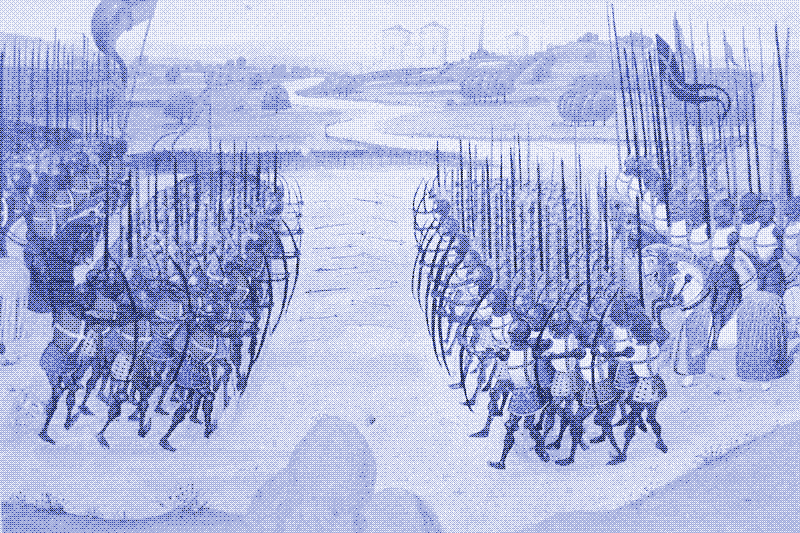
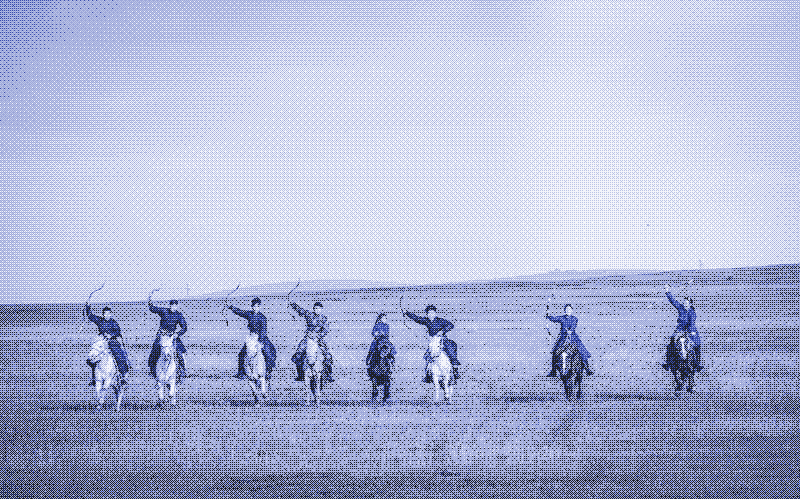
At the same time, horse archers were not interested in firearms or crossbows because their battle tactics depended on a high rate of fire. Those weapons would have forced them to completely revise their tactics, which had proven very successful – even against European cavalry with early firearms. 49 Native American horse archers also killed European colonists far into the nineteenth century. In the hands of the horse archer, the bow only found defeat when it met the repeating rifle.
Sustainable violence?
Advocating for a revival of the bow and arrow – at the expense of the firearm – sounds absurd and unrealistic. But is it? Reintroducing the bow would only bring us benefits. It follows the same sound thinking behind other low-energy strategies, such as switching from cars to bicycles. The bike and the bow are both highly efficient, human-powered technologies that would be advantageous to human and planetary health.
First, reverting to the bow and arrow would be a pacifying move. If firearms made it possible for states to build larger armies and fight wider wars, then reverting to bows and arrows – and other historical missile weapons such as trebuchets, catapults, and ballistas – would bring us less extensive conflicts. It would decrease the number of people in a given population who could become effective soldiers (unless archery practice becomes ingrained in daily life again). A society that switches from cars to bicycles would similarly bring shorter travel distances and more local ways of life (unless people train by cycling dozens of kilometers per day).
Reverting to the bow and arrow would decrease the number of people in a given population who could become effective soldiers
Second, reverting to bows would make warfare less damaging to the environment. We don’t often assess weapons in terms of energy efficiency and sustainability. However, the production of firearms and bullets depends on an intricate global supply chain that involves infrastructures, factories, mines, and fossil fuels. So on top of the human suffering that firearms cause, they also pose a longer-term problem, just like other modern technologies.
On the other hand, bows and arrows can be hand-made from many natural and human-made local materials (See “When lethal weapons grew on trees”). Furthermore, artisanal production has an additional pacifying effect. Early firearms were hand-made products just like bows, and in both cases, the weapon supply was limited to what craftspeople could produce. With industrial manufacturing methods, these limits disappeared, facilitating large armies and extensive fighting.
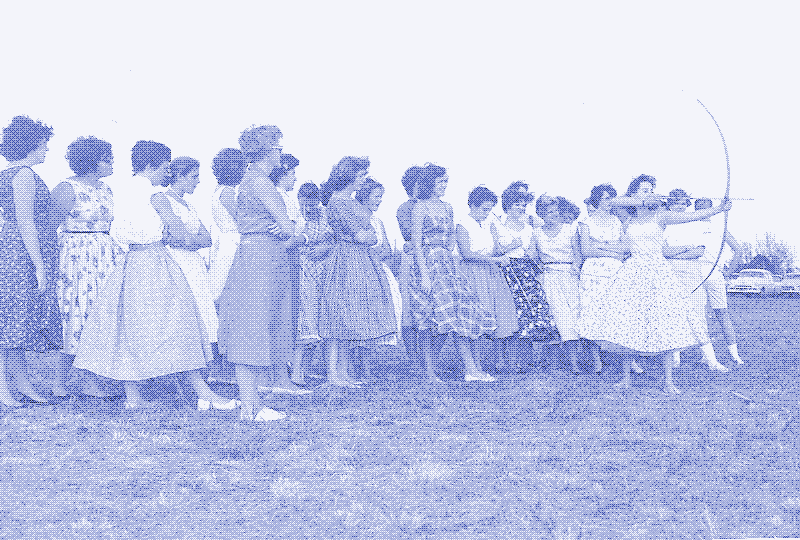
Third, low-tech manufacturing methods based on local materials also provide military self-sufficiency – the condition in which a state (or another political organisation) is able to procure or produce domestically quantities and qualities of miliary supplies, raw materials, and equipment for its survival or its foreign policy goals in general. 34 For example, modern ammunition depends on antimony, concentrated in China. Without it, we could not sustain the bullet speeds of today. 5152
It’s possible to build firearms with more local, low-tech manufacturing methods, but these would not have the same performance characteristics. For example, the British Sten machine gun – an important weapon during World War Two – can be made in a bicycle shop using minimal welding and machining. However, it was a notoriously unreliable weapon, and its maximum range was only 100 meters, easily surpassed by a skillful archer. 53
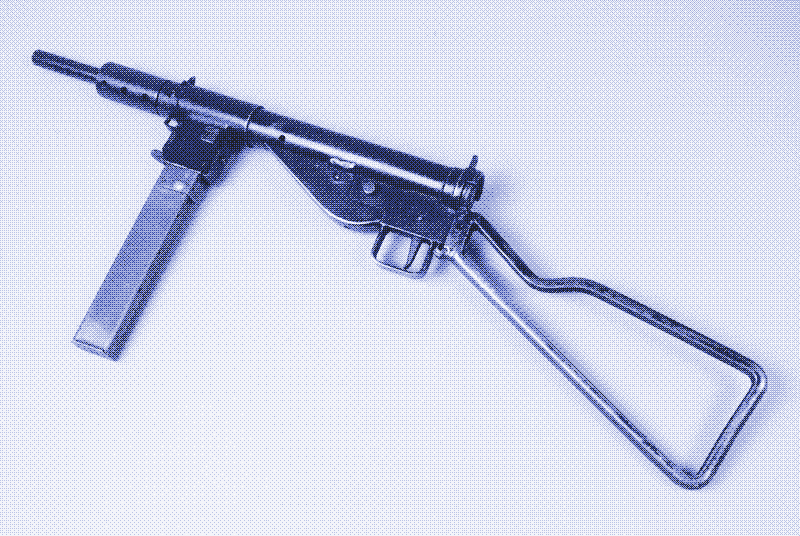
Finally, replacing the firearm with the bow would reduce the damage done by missile weapons in a civilian setting, such as mass shootings, accidents, and suicides. In theory, a mass shooting could happen with a bow and arrows. However, it would take an archer years of dedicated practice, while a gunner can start out of the box. Bows are also much less likely to cause lethal accidents when not in use. Unlike firearms and crossbows, they cannot be carried and stored in a loaded position. 11 Finally, the bow is a very unhandy weapon for suicide – it would require you to pull the string with your toes while aiming at yourself. 11
Military technology leads by example
Even if you agree that reverting to the bow and arrow would bring advantages, you probably find it unrealistic. That may well be true, but in that case, it’s also unrealistic to make a transition to a more sustainable society. We cannot combine a low-tech lifestyle with high-tech weapons for several reasons.
First, military technology is one of the main drivers of technological progress. Many products that are destroying our environment were originally developed for military purposes. Second, the global supply chain that underpins modern firearms is at the heart of economic growth and all environmental problems. We cannot keep it working only for manufacturing weapons and dismantle it for all other purposes. Third, the capitalist system needs rising levels of military spending as an outlet for growing amounts of accumulated surplus capital. The global economy invests heavily and increasingly in warfare, conflict, and repression – high-tech weapons are big business. 54 55 56
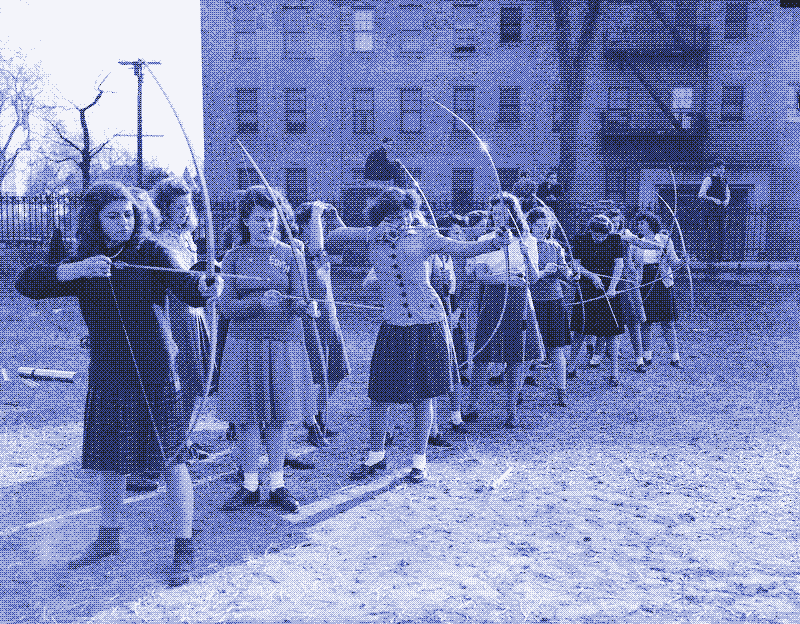
For all these reasons, rather than keeping weapons out of the sustainability discussion – they should be our focus. If we cannot imagine low-tech warfare, we cannot imagine a low-tech, sustainable, and fair society. Switching to low-tech weapons sounds unrealistic because it would require global cooperation, but the same holds for lowering the emissions from fossil fuels. Switching to low-tech weapons sounds unrealistic because it involves “uninventing” things, but this also applies to many other problematic everyday products.
Indeed, military technology is one of the few domains in which we have collectively decided not to use certain technologies. Humanity has banned many types of weapons in warfare, such as chemical and biological weapons, blinding laser weapons, and poisoned bullets. Meanwhile, no country has succeeded in outlawing SUVs, although their danger to other road users and the environment is well-known. As weird as it sounds, military technology leads by example.
Reactions
To make a comment, please send an e-mail to solar (at) lowtechmagazine (dot) com. Your e-mail address is not used for other purposes, and will be deleted after the comment is published. If you don’t want your real name to be published, sign the e-mail with the name you want to appear.
Reactions
Steph
Thank you for this article. I am a range safety officer and rifle, pistol, and shotgun instructor.
Your general point about bows requiring more skill to use than firearms is true. However, I disagree that “Pulling the trigger of a firearm does not require any skill or practice.”
The “pad” of the finger must be placed on the trigger for an accurate shot. Novice shooters often use the joint closest to their fingertip to pull the trigger, which causes the gun to point in an unintended direction.
Shooters must also be trained on the speed and pressure to use when pulling a trigger. Shotguns require shooters to “slam” the trigger (when shooting flying targets), while other firearms require a gentle “squeeze” or two squeezes if the trigger has is two-stage.
These skills take diligent practice to master.
Archery has four important drawbacks for hunting:
You must be closer to an animal to harvest it. This is less important in regions that use ambush hunting (e.g. tree stands), but plains or desert usually require stalking. As effective range decreases, your likelihood of harvesting an animal decreases, since the animal could be scared off when you approach.
Archery is more affected by wind than firearms are.
Deer can hear the “thwack” of a bow or crossbow and duck out of the way of an arrow or bolt. Because of this, hunters must compensate by aiming lower.
Archery cannot penetrate brush as effectively as firearms. Because of this, there are fewer shot opportunities in wooded environments if you do not use a firearm.
In hunting, weapons are often used closer than their effective ranges to maximize lethality and minimize the chance of suffering for animals.
There is also a spectrum of low to high-tech with firearms. A muzzleloader is more sustainable than a break action rifle, which is more sustainable than a machine gun. The easier a firearm is to repair and source ammunition for (without global supply-chains), the more sustainable it is.
Other low-tech weapons that are still useful for hunting are spears, slings, slingshots, and airguns.
I think the best plan is to use a mix of low-tech and high-tech weapons depending on the activity. Hunting and target shooting with archery are commonplace and could become more popular. Self-defense, law-enforcement, or military applications with a bow are unlikely to be practical, since criminals and rogue nation-states will continue to use firearms even if they are banned. For self-defense, there are low-tech solutions, such as martial arts, edged weapons, and blunt weapons.
Thank you,
Seth
Kris De Decker
Declan, thanks for the link.
I read a few articles but don’t understand the author’s arguments. Does he come to the opposite conclusion because bows were not as good as other sources say or because muskets were better?
I think the problem is that this author only relies on historical sources. There’s a reference in my article [2] which explains the problem with this approach in relation to the range of bows. Therefore I also included scientific experiments with replica’s of old weapons, results from archery contests in the early twentieth century, and so on.
For example, there are many historical sources that claim rather extraordinary feats by archers. Those may be true but may well be exaggerations for many reasons. The author also quotes several references from when the English debated the merits of bows versus firearms. Both sides in that debate did not agree about performance characteristics, for obvious reasons. That is an issue that several of my references also treat.
It took me eight months to finish this article because there are a lot of inconsistencies in historical material about weapons. Meaning it is easy to select the data that support your argument. Of course I may have fallen prey to the same problem, but this author doesn’t convince me.
W
For local, low-tech firearm manufacturing the Palestinian Carlo may be of interest. Sometimes made from homemade parts, sometimes assembled by recycling broken or obsolete weapons, sometimes by upcycling airsoft or paintball guns, usually welded in motor shops or on construction sites. Magazines may be jury-rigged to hold different calibres from the original. Operational life span is certainly less than the average longbow, though probably longer than the 3D printed handguns everyone was worried about a few years ago.
PS- in article link to “When lethal weapons grew…” is broken.
Cheers,
W.
Tjeerd
Dear Kris,
I love the website and and I implement quite a few technologies myself
it our as sustainable as reasonable organic farm.
It seems that you were not aware of the work of Jörg Sprave and his
slingshot channel. See for example:
https://www.youtube.com/watch?v=xUMBKcRwl9k
He has been at the basis of a development of hand powered weapons that
closed the difference between guns and “crossbows”. Quite impressive
actually. Also what one can make from plywood with minimal tools at home.
Best,
Tjeerd
Renzo
Hi, Kris
I’ve been reading all of your articles in both Low-Tech Magazine. It’s a little bit shocking to me that you included violence in the sustainability topic but violence will never become sustainable because the main goal of war is to win or to defend so your country must use anything at all cost possible to defend. However, accessing in low-tech weaponry is good for self-defense for the civillian people since many cannot afford even the cheapest guns especially in my country which is very poor.
Low-tech weaponry is cheap, easy to produce, and accessible for everyone, arming civillians with a low-tech weapons could prevent mass shootings for worsening the number of kills, 20 people equipped with bow/crossbow in an area could prevent 1 shooter for going further massacre or robbers from robbing the store and also it can enable you, your neighbours, family, and friends to defend yourselves from violent crimes, it is not perfect though, it wouldn’t always saved someone’s life especially if the aggressor equipped with more advanced weapons but atleast the victim/s could fight unlike the unarmed when there is a shooter/aggressor, all that they can do is hide and run for their lives defenselessly. The only problem is that government keep banning self-defense weapons even if it is not a gun.
The best thing about low-tech weaponry especially if made out of sustainable material such as wood is that it is applicable for mass ownership since it doesn’t create a lots of material waste pollution if disposed, and the projecticles/ammo/arrows can be produce locally , don’t need to rely on imported products/materials just to get reloaded.
Here are my favorite low-tech range weapons I’ve found.
Bow with an arrow magazine - This is the most semi-automatic bow I’ve seen, the arrow magazine let archer shoot arrows without the need to pick arrows from the quiver one by one.
Chinese Repeating Crossbow - The chinese repeating crossbow is the fastest crossbow in history, however it is not used in the battle since it lacks range, and power. As far as I know, it was only used to defend against home invasion where aggressor is just in the close range enough to get killed by this crossbow
Gastraphetes/ Belly Bow - I don’t much know about the history of this crossbow but it is one of the fastest way to reload a crossbow by pushing the front wood using the belly, although not as fast as chinese repeating crossbow but it has an advantage of range and power that is applicable in combat.
Alcohol powered gun - This gun shoots marble or any light circle material, it has an effective range of 50 meters and the maximum of 100 meters. Although, the materials used came from an industrial output but it is mostly/all made out of recycled materials and the handgrip, stock and the barrel can also be made out of wood and bamboo, the reason I included this is that it is very easy to make, it make good use of the waste materials and most importantly is that the propelling charge is alcohol which is very locally available and can be made locally, unlike gunpowder which is expensive and hard to find but denatured alcohol is mostly used for extra power.
Shepherd Sling with stick handle - The stick handle gives more effective range which compared to just sling only
Atlatle/ Spear Thrower - It as simple as stick with a hook where you can place your spear and throw it with more power boost compared to hand throw only.
Chakram - it is a throwing circle metal with a hole in the center. It has been said that it was more easier to throw than knived and axes since this weapon has an aerodynamic shape which lowers the air resistance when thrown. An expert chakram thrower could easily cut limbs of a person. Just like bow, the user’a need to have a skills to be able to effectively throw.
Blowgun - This weapon is easier to make than bow, the tips is usually dip in a poison to make it deadly. The propelling force of the blowgun doesn’t only came from blowing, it can also came from compressed air, or alcohol just like the marble gun.
Crosbow slingshot - crossbow slingshot just like crossbow, it gives an advantage of accuracy than ordinary slingshot. Although the rubber came from industrial output but it is easy to make and doesn’t need gunpowder to propell the projectiles.
Liam
Kris,
Thanks for the thoughtful response. I wouldn’t want to presume on your time, but I think the content of Ashley’s PhD together with nonviolent civilian defense could definitely form the basis of another article. Something about how the abolition of militaries isn’t as impractical as it seems.
I’m not sure such a topic quite falls under low tech in the same way bows and arrows do, but it does present an alternative to an unsustainable part of the modern world, and a reasoned argument against a default modern assumption.
Ashley
Dear Kris,
I apologise in advance for a long email, but I hope you are able to take the time to read it. I love your blog, and my partner and I have the book versions as well. I was just this morning reading your recent post ‘What if We replace Guns and Bullets with Bows and Arrows?’ I’m currently in my final year of a PhD. on war prevention so the post caught my attention. I don’t usually like writing in the comments, but I hope it is okay for me to write to you with some thoughts and a suggestion I have on this. I also want to be clear, these only pertain to the extent to which you discuss sustainable war, not weapons generally. Weapons have a wide range of uses (eg. hunting) and I have no issue (or knowledge) on those aspects of the post.
There are three key parts to my thoughts:
The least resource intensive weapons already are used in warfare and cause huge amounts of damage to the civilian population.
You are overlooking a significant sustainability impact of war, which is the resource use required because of the weapons use.
I think that you overlook the most sustainable alternative, which is not ‘greener’ weaponry.
The nature of war is to kill and harm. War pursues a logic of trying to cause as much destruction and hurt as possible, so that the opponent is unable or unwilling to continue. In a modern war, 90% of the casualties are civilians. Modern wars also do not often ‘end’ in a clear victory or defeat either, but are usually ended through a peace negotiation. This is possibly connected to the high civilian death rate— those suffering are not the ones able to end the war.
Yet this high death rate comes only in part from direct battle. Much of the harm caused is potentially ‘sustainable’, at least using the understanding you adopt in the post of a focus on the resources used to create weapons. This is because the spread of disease, cold and hunger do not need weapons per se, but just the destruction of the community’s infrastructure. This is both physical, such as roads, stores, farms, health clinics etc; as well as bureaucratic, for example, people flee and leave no staff to manage the department of health, or the port, or to take responsibility for sewer repairs. In this sense, hurt and destruction in war is spread not only through ‘direct’ violence, but also through the disintegration of the taken-for-granted, life-supporting systems that we all rely on.
With that context, the first thing I wanted to highlight is that in speaking about ‘sustainable’ weapons only from the perspective of ‘physical’ weapons, you ignore the huge harm caused by ‘sustainable’ (ie. low resource intensity) weapons currently (starvation, death through preventable disease, etc.). These take an enormous toll on civilian population (who are the predominant victims in modern war). I think that any discussion of modern warfare and the weapons it uses ought to address this.
The second point I wanted to raise is that you write only from the perspective of the resource intensity of the weapons creation and use. In doing so, you are ignoring perhaps the most significant sustainability impact war, the destruction it causes. This is particularly significant because it is also the intended impact of the weapon. Even the most sustainable weapon is designed to harm and destroy, and it will destroy things that need to be there. That is the point of weapons. They do not target the superfluous. This means that every time a weapon is used, there will need to be energy and resources put into repairing and re-building. This is all extra resource use, and ranges from hospital resources, to physical buildings to farms. What’s more, this repair may need to occur many time over because ‘re-builds’ during elongated conflict many be destroyed multiple times. It strikes me, that war cannot ever be sustainable, not because it is ‘unrealistic’ that militaries will use sustainably sourced weapons, but because the impacts of all warfare will necessarily demand extra resource use.
And this brings me to my final point, which is that when it comes to war, the real sustainability comparison is not bows and arrows vs. guns and bombs. The real comparison is war or not-war. Although it is not regularly spoken about, preventing war is entirely possible. Indeed it is the norm, both currently and historically. Anytime a war occurs, we should be viewing this as a policy decision, and one for which there were many alternatives.
So to be clear, my criticism is not that a low-tech weapons transition is ‘unrealistic’. You rightfully point out that weapons ban campaigns are often successful, and often successful despite military opposition. My criticism is that weapons transition is the wrong idea to be promoting. When it comes to war, the sustainable option is not to have war at all.
I know it isn’t really my place to ask, but I wondered if you would consider editing your blog post? To me, your blog post might be better to speak only about weapons (which have uses beyond war, such as hunting), and to avoid speaking about the sustainability of warfare. War and organised political violence is a very complicated area, and whilst there is a lot to say in relation to resource use and sustainability, the relationship is more complex than the post currently gives them credit for.
As I mentioned, how wars are avoided is the topic of my PhD. research, and it’s something I’m happy to speak to you about more (via zoom or email). What I would emphasise now though is that not-only is war prevention realistic, it is actually the norm.
I apologise for such a long email, I hope you don’t mind me writing to share my thoughts on this matter. As I mentioned earlier, I’d be happy to email more, or to call and speak.
Thanks again for your time,
Ashley
Declan
A somewhat less optimistic take on the performance of bows vs early firearms, especially accuracy and range (they agree with you on lethality vs ROF), using many period sources: https://bowvsmusket.com.
Interestingly the author also doesn’t think that guns were easier to train! https://bowvsmusket.com/category/conclusions/
Barry
I live in a house named “The Butts” on the edge of the parish of Orcop in England. My modern house is close to an old farm building currently being rebuilt, also named “The Butts”.
In this area the old field names survive. Nearby are two fields named “Long Butts” and “Short Butts”.
Could this be because two skills were practiced. Direct shooting and up and over shooting?
Simon Robinson
A poster above mentioned Gene Sharp’s work on nonviolent civil defence, here is a short article describing how such an approach could have been used in Ukraine.
https://wagingnonviolence.org/2022/02/ukraine-doesnt-need-to-match-russias-military-might-to-defend-against-invasion/
A major advantage of this approach (from the perspective of this blog i.e. of sustainability and low-energy solutions) is that in civilian self-defence nothing gets destroyed and so nothing needs to be rebuild (the massive destruction in Ukraine means it is going to need staggering inputs of materials and energy to rebuild….especially if they continue business-as-usual rather than rebuilding in a sustainable way)
Agammamon
If everyone except one guy has a car, then ok, we can handle that.
If everyone except one guy has a gun - then he rules the world.
Hyperbole, but there you go. As long as someone else has a gun, I want one too.
Plus, its hard to shove a bow down your pants without people noticing;)
Joshua
If nothing else, arrows grow on trees and lead does not. I suspect bows and crossbows are where we’ll end up in the end. Maybe black powder will continue for a millennium or two, but if humanity chugs along another million years or so before going extinct, then the Firearm Era will have barely been a fad.
My interest in Low Tech comes from a Peak Oil perspective, so I can easily see a resurgence in bows, especially crossbows, as supply chains wither. In the U.S., where I am, ammunition prices skyrocketed during 2020 and haven’t really come down. Even the money savers who load their own ammo got screwed because reloading supplies vanished. Crossbows provide cheap (if not free) and easy-entry recreational shooting, pest control, hunting, and also home defense in a pinch. More likely, they’ll increasingly be used for the first three, with firearms saved for the last.
Perhaps, even after millennia, there is still room left for improvement. Hopefully, a “semi-automatic” crossbow can be achieved. One shot every ten seconds may as well be forever in a serious situation. The various repeating crossbows I’ve seen online haven’t impressed me: they seem more like potentially dangerous toys than something I would bet my life or livestock on. Crossbowmen started the Middle Ages with 50–100 pound hand-pulled weapons and finished with 1000 pound crank-drawn ones. I’ve wondered if the jumbo prod could be attached to the smaller crossbow and used to reload the weapon. A more likely achievement I think would be a crossbow with two bows and two triggers, the William Tell equivalent of a double-barreled shotgun. Excalibur sells such a crossbow, called the TwinStrike (more like the WalletStrike, I’ll build my own, thank-you-very-much).
My major disagreement with the article is the one you saw coming: I can’t see countries voluntarily going this route until there is literally nothing else. The weapons we’ve agreed to ban are mostly things with a poor sadism-to-usefulness ratio. Blinding weapons, poison, and torture can be classified as “pointless cruelty”. Chemical and biological weapons aren’t much better. From what I understand, they aren’t particularly effective against modern equipment and procedures, while being far less controllable. You can douse high explosives in gasoline without them going off, but if some rando drops a petri dish we’re back in 2020. Countries that can build thermobaric and nuclear weapons, conveniently also the most powerful, have a strong incentive to pressure the rest not to use these marginally-effective WMDs.
Firearms, on the other hand, would provide an extreme advantage to the party who breaks the agreement first. I don’t think it’s unfair to say that Spain, with guns, could take on all Europe without guns. Building hydroelectric plants and mandating eco-efficient housing will improve national quality-of-life over time; the military is what stops it from being conquered right now.
I do think there will be military downshifting in the future, but as a consequence of peak oil and resource depletion. A lot of military equipment requires a industrial supply chain. Predator drones full of complex electronics and rare materials will be increasingly hard to field in large numbers. Stockpiles will diminish, maintenance will diminish, performance will diminish, and commanders will be forced to make do. Everyone will prop it up as best they can but one day they’ll wake up and notice they’re barely being used, except in a bare bones form. None of this will occur by mutual agreement in the vast majority of cases. One exception, nukes: they are expensive and, really, you only need to kill the world once. China, France, India… they understand this. I suspect that within thirty years, some future Biden and Putin will split a Nobel Prize for limiting their arsenals to a few hundred missiles apiece.
Continuing with the Peak Oil Path To Arrows: some aspects of modern war are more resilient than others. The ones that survive will go together in an eccentric mix-and-match. For instance, the Anarchists of the Russian Civil War did very well for themselves by attaching heavy machine guns to light horse-carts (The “Tachanka”). The Wehrmacht also did well with outdated bolt-action rifles, by training the entire squad to be support for one guy with a general-purpose machine gun. Eventually the machine-guns will go too, and even simpler weapons will remain. Boxlock shotguns, falling block rifles, and single action revolvers will be that which survives.
Perhaps that is how guns will go extinct, but perhaps they can be made truly sustainable. Sustainable black powder, made without sulfur, does exist. Ignition without chemical percussion caps is possible via a fire piston. A discontinued junior rifle called the Daisy V/L showed that the concept is feasible, and I suspect someone is going to make a mint soon by fitting one into a black powder rifle and making caps obsolete. The projectile is less clear but perhaps a concrete slug, fitted in a sabot, is doable? I can picture a three-pound monstrosity of bog iron, recognizable as a revolver, holding three or four ninety-caliber bullets and launching them fifty yards or so. A better home defense weapon than a one pound, eleven-shot Springfield Hellcat? No. But I’d take it over a crossbow.
Also, as a first-time commenter, I just wanted to toss in that I love your website. You’re doing God’s work.
verdigris
A very interesting article, I am glad to see thinkers in sustainability considering violence and war as well, there is a tendency among the environmentally concerned to forget that war is inevitable and natural.
I am inclined to agree with Joshua that resource shortages will be the likely driver of the adoption of lower tech weapons, as very few nations are like to willingly give up superior weapons in the face of an uncertain future. Precision guided weapons will be the first to go, the complex supply chains needed to produce the sophisticated electronics will not survive a small civilizational shake up, so weapons that can be made locally with short supply chains would allow for more soldiers to be equipped at lower cost.
Basic firearms can be made more simply than they currently are, steel cartridge cases and corrosive perchlorate primers are suboptimal but much cheaper and easier to produce than high quality modern cartridges. Very simple grenades and rockets similar to the last ditch weapons used by Germany and Japan at the end of WWII could be made much more cheaply than more sophisticated modern versions.
Another technology that could survive a collapse better than firearms is airguns, airguns have existed since the 1500’s but the expense of precise machining and making pressure vessels prevented widespread adoption. Precise machining technology is unlikely to disappear even if power must be supplied by waterwheel or biomass burning hot bulb engine. Airguns can shoot slugs at similar velocities as pistol rounds and early black powder cartridges, this is inferior to modern high velocity rifle rounds but with good projectile design and optical sights effective ranges of 200-300m are achievable. Precise machining is required but projectiles can be made from lead, copper, or even steel if supported in a soft plastic sabot. The only material needed other than steel is something for airtight seals, rubber is ideal but leather can be used. Compressed air tanks can be refilled in field with hand pumps (though not in combat), and since muzzle velocities are already limited to around the speed of sound firing suppressed at subsonic velocities will not seriously decrease effectiveness.
ArcheryEnthusiast
Realistically, there is one and only one prospect for this to happen- forces armed with preindustrial weapons would have to consistently prevail over forces armed with contemporary weapons. Personally I don’t see that happening any time this millennium.
Rodrigo Fernández
It seems wrong to me to suggest that primitive firearms were not technically superior to bows and arrows, in at least four respects:
The latest plate armor was extremely difficult to pierce even by arrows fired from the most powerful bows a human with years of hard training could wield. Tod has done a lot of experiments on this matter https://www.youtube.com/@tods_workshop . On the contrary, the bullets went through them like butter, making them immediately obsolete.
The damage produced by the bullets is much greater than that produced by the arrows. In the battle of Lepanto, the Christians, who used firearms, were satisfied with their performance and estimated that the greater destructive power more than compensated for the higher rate of “fire” of the Turkish bows.
Arrows are huge, while bullets are tiny and easily portable.
The discharge of firearms produces a strong psychological impact, which is a very important factor in war.
On the other hand, if ease of handling had been the only determining factor in abandoning bows, and technical considerations had not played a part, crossbows might well have been adopted, which are even simpler to handle than primitive firearms, and moreover more cheap and required the use of fewer special materials such as iron, lead and gunpowder.
Regards
Davud
I am comenting as a marksman,with anything from a thrown stone to a rifle,with the latter I can put three bullets in the same hole and with the former I can kill a duck at 150'
Hand eye cordination and practice.
Bows require much more core streagth and focus,sling shots require stealth and secret knowlege…
cross bows are just terrifieing
and if you want to know about the ultimate human powered weapon,
then check out foot bows,with a range of over 5 miles firing steel bolts
thrown knives are a good minimalist equipment type of marksmanship that require much of the same skill set
and trick shooting with even a pellet gun is a valid test of competency
Bob BAAL
Let’s look at this.
100 good bowman vs 10 machine gunners each with a Sten gun.
They are 50 m apart and each carry as much ammo as they can carry/chose.
Two Stens malfunction two of the bowman snap their strings. (Note for the Sten that is a much higher failure rate than actually happened in practise).
End result 2-3 wounded Sten gunners 100 dead bowman. Every time. Simples.
The only real way for a bowman to beat a gunner is to catch the latter by surprise.
A Sten can be made out of very average steel in a very average machine shop no hi tech required.
Dave
Umm… love your work but I’m writing this on the West Coast of North America. In case you hadn’t heard, the indigenous bow-and-arrow people were almost completely wiped out in short order by firearms (and a bit of smallpox).
It’s not even an argument. As long as firearms exist, they will be used and they will win.
superkuh
It is significantly harder to cleanly kill a deer without it suffering when using a low energy delivery projectile like an arrow. A .308 shell firing a bullet out of a long rifle delivers enough energy to instantly kill a deer. At least for hunting, the primary purpose of firearms, arrows are less cool if you care about animal suffering (and meat quality).
NoName
Agreeing(21), I think it’s worth noting that this has been a pretty common debate. The following link is a SpaceBattles thread on this subject, https://forums.spacebattles.com/threads/bows-vs-muskets.154316/
From what I’m seeing here, is that the discussion tends to be quite centered on English longbows. If one broadens the horizon of discussion, it’s easy to note that guns caught up even in countries with strong archery traditions such as Japan. The Native American cultures similarly also quickly embraced guns as quickly as they could, even if it entailed depending on trade with Europeans to do so. Moreover, one can note that all these cases center around matchlock arquebuses and not earlier guns.
As for crossbows, one has to consider that the type that arbalests and similar crossbows didn’t really have a higher rate of fire than muzzle-loading guns, all the while being mechanically more complex due to the need for windlass mechanism. Moreover, the bow limbs made them bulkier and more awkward to handle.
Finally, I think I should piggyback on (18) by noting that historically, there’s been a few experiments in using alternative materials for ammunition:
https://www.forgottenweapons.com/overview-of-danish-schouboe-45-32-caliber-pistols/ The first is the Schuboe pistol, which used a wood-cored projectile. This, apparently, would be a good choice for low-power rounds intended for close-range use as it’d be likely to cause griveous wounds, yet it’d be unable to be used at range.
https://www.thefirearmblog.com/blog/2016/09/19/modern-historical-intermediate-calibers-022-7-92x40mm-cetme/ A second noteworthy experimental round is the 7.92x40 MM CETME, which was made of an aluminum core with a gilding metal cladding, which, combined with the round’s length, enabled it to be longer-ranged than conventional ones.
Finally, it’s known that in late WW2, Germany resorted to making sintered iron rounds, which would be more energy-intensive but have less deleterious effects on the local environment than lead rounds. Of course, one would then also have to note that modern buckshot is often made of steel as well.
Charles W. Fink
Hello Kris, I just found your website, it is very interesting. I got here in my search for a subject I saw in a library book written back in the 70s. It was an article about a design using ropes and pulleys attached to the tops of several trees that used their movement in the wind to generate power.I think it might have been to pump water, but I don’t remember, it was back in the 90s. It may have used a ratchet drive or a rack and pinion. Anyway it seemed pretty clever, there was a web work of ropes to at least three different trees, the ropes didn’t have a lot of travel but they would have had considerable force, and whenever they pulled away from the central spool or flywheel they would contribute to its rotation. Have you ever come across this? It just so happens one of my hobbies is making modern hurling devices. I’ve built two whipper trebuchetes and three ballistas (giant crossbows). If you search ‘Steampunk Inswinger Ballista’ on you tube you can see a few short videos of a pretty cool art and engineering project. I just finished a Ravin R18 (unusual modern compound crossbow) inspired ballista that is ready to be tested. I don’t hunt, they are just functional art projects to keep my mind and skills active. There is an ancient Chinese triple bow called a San Gong Chuangzi Nu that is worth a look. Great website, I am looking forward to exploring it.
bow origins
“Unless the target is very close, the archer needs to compensate for gravity and shoot the arrow in an arc – hence the word archery.”
I’ve seen this elsewhere like in tvtropes and in English it seems self-evident so no wonder it spread, but the arc in archery surely must refer to the bow, from Latin arcus “bow”, or Spanish arco which means both arc and bow.
Alexander Lopez
Back in 2016, a cowboy in Oregon stopped a thief with nothing more than a rope: he chased the bad guy on his horse, threw a lasso, and tied him to a tree until the cops arrived. As he told the policeman, “Man, you guys ought to pick up a rope and throw that gun away. You might have better luck with it."
Source: https://www.cbsnews.com/news/hero-oregon-cowboy-lassoes-attempted-bike-thief/
Anonymous
I feel like a lot of commenters here are missing on two key problems of firearms in a modern context: legality and costs. Which, together, mean the more disenfranchised the community, the harder it is to access them.
I live in a country where gun ownership is tightly controlled. When guns are made illegal only privileged fucks have guns; because laws are necessarily enforced by cops and the police will always, by the very nature of the institution, side with the powerful. As the world moves deeper into ecological catastrophe, marginalised communities such as immigrants, Black people, queer people etc. will continue to be targeted (we already see this happening), and while rich white Americans may enjoy private bunkers with a collection of assault rifles and huge ammunition stockpiles, most of us won’t ever have the luxury. Racist fanatics caught with machine guns get a slap on the wrist, but if the police as much as sniff too much interest in guns I’ll end up deported.
Low-tech weapons may not win in direct confrontation with guns, but I believe these two articles show they’re more tactically valuable than most people imagine. I especially commend the author for pointing the value of worse-is-better solutions—for example, that while making an excellent bow is a craft that takes years of practice, making a halfway decent bow is within everyone’s reach. This can make a lot of difference for resistance fighters, autonomous communities, little queer homesteads, ecoguerillas, forest defenders and all other good folk.
To give one concrete example, a few months ago a leftist squat was assaulted by a gang of neonazis, who burst open the door, gassed people with pepper spray, and rendered them helpless by drawing a gun. Underreported on the media was that this was their second attack in one week; the first one was testing the waters, throwing rocks and insults but not trying to get in. Furthermore, the squatted building was a two-storey, meaning the enemy was in clear view and lower ground until they invaded. Now of course any anticapitalist who owns a gun would be jailed, which makes it hard to keep them at closely monitored spaces such as a politically-motivated squat. However, even if you’re not allowed to walk around with crossbows or slingshots, you can’t be arrested for having them at home (yet). If the antifascists had a culture of crafting, practising, sharing and stockpiling low-tech weapons, that assault would have ended quite differently, and it would have pushed the local neonazis back into their holes rather than emboldening them to continue escalating. Which they have.
Anonymous
W.
For local, low-tech firearm manufacturing the Palestinian Carlo may be of interest. Sometimes made from homemade parts, sometimes assembled by recycling broken or obsolete weapons, sometimes by upcycling airsoft or paintball guns, usually welded in motor shops or on construction sites. Magazines may be jury-rigged to hold different calibres from the original. Operational life span is certainly less than the average longbow, though probably longer than the 3D printed handguns everyone was worried about a few years ago.
PS- in article link to “When lethal weapons grew…” is broken.
Cheers, W.